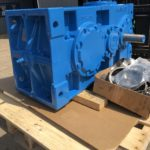The industrial landscape is a symphony of movement. From colossal factory lines to intricate processing plants, machines whir, gears turn, and components work in perfect harmony.
But behind the scenes, a silent hero ensures the smooth operation of countless applications: the speed reducer. While often overlooked, speed reducers play a crucial role in optimizing performance and maximizing efficiency within industrial processes.
What is a Speed Reducer?
A speed reducer, also known as a gear reducer, is a mechanical device that, as the name suggests, reduces the speed (and often increases the torque) of a rotating input shaft to a desired output speed. It’s essentially a system of gears configured to achieve a specific gear ratio, translating rotational speed from a high-speed motor or engine to a slower, more manageable speed suitable for driving various machinery.
Why Use Speed Reducers?
Speed reducers are ubiquitous in industrial applications for several key reasons:
Optimizing Machine Speed
Many industrial processes require specific, controlled rotation speeds. Speed reducers allow for the utilization of high-speed, powerful motors while delivering the precise output speed needed for the machinery. For example, a conveyor belt transporting materials might require a slower, steady rotation for efficient loading and unloading while the motor driving operates at a much higher speed.
Increasing Torque
The principle of gear reduction often increases torque, the twisting force acting on the output shaft. This allows for the utilization of smaller, more efficient motors to drive machinery requiring high torque for tasks like crushing, mixing, or lifting heavy loads.
Smoother Operation
Speed reducers can help to dampen vibrations and jolts from the input motor, resulting in smoother, more consistent operation of the driven machinery. This reduces wear and tear on components and contributes to a longer machine lifespan.
Types of Speed Reducers
Speed reducers come in a variety of configurations to suit specific application needs. Here’s a glimpse into some common types:
- Worm Gear Reducers: These offer high torquereduction ratios in a compact design, making them ideal for applications requiring slow, powerful output speeds.
- Helical Gear Reducers: Known for their smooth, quiet operation, helical gear reducers offer efficient power transmission and are suitable for a wide range of industrial applications.
- Planetary GearReducers: Compact and lightweight, planetary gear reducers offer high-speed reduction ratios and are often used in applications requiring high precision and space limitations.
Selecting the Right Speed Reducer
Choosing the right speed reducer requires careful consideration of several factors, including:
- Required Output Speed and Torque: The desired speed and torque of the driven machinery are paramount in determining the necessary gear ratio and overall capacity of the speed reducer.
- Application Environment: Factors like load type (continuous or shock), operating temperature, and required level of efficiency all play a role in selecting the most suitable speed reducer for the specific application.
- Duty Cycle: The duration and intensity of operation (continuous, intermittent, etc.) should be considered to ensure the chosen speed reducer can handle the expected workload.

Keep Your Industrial Operation Running Smoothly with OurSpeed Reducer Repair
Is your industrial equipment lagging due to a worn-out speed reducer? Don’t replace it! Hanson Gear Works offers expert repair services to restore your speed reducer to peak performance. Contact us today for a free quote and experience the Hanson Gear Works difference!
